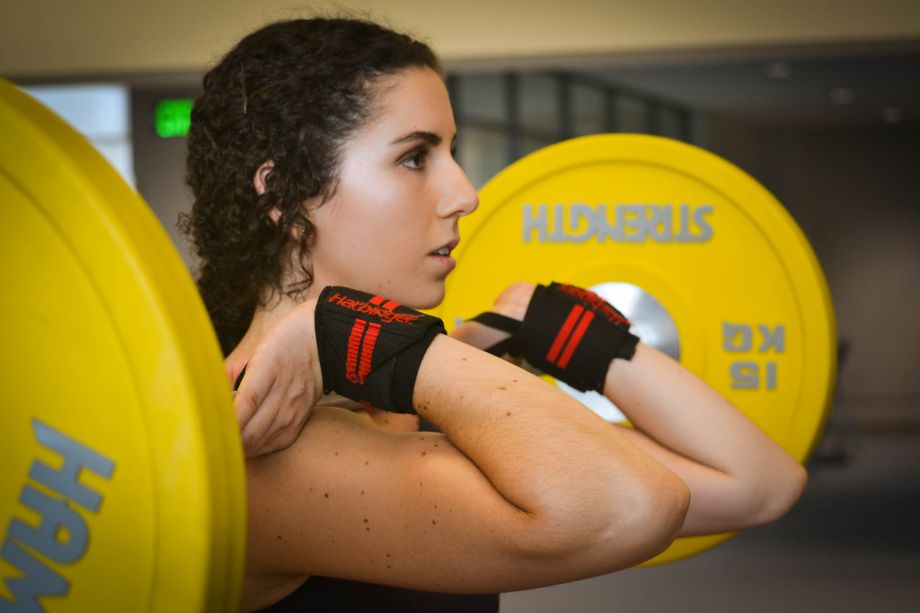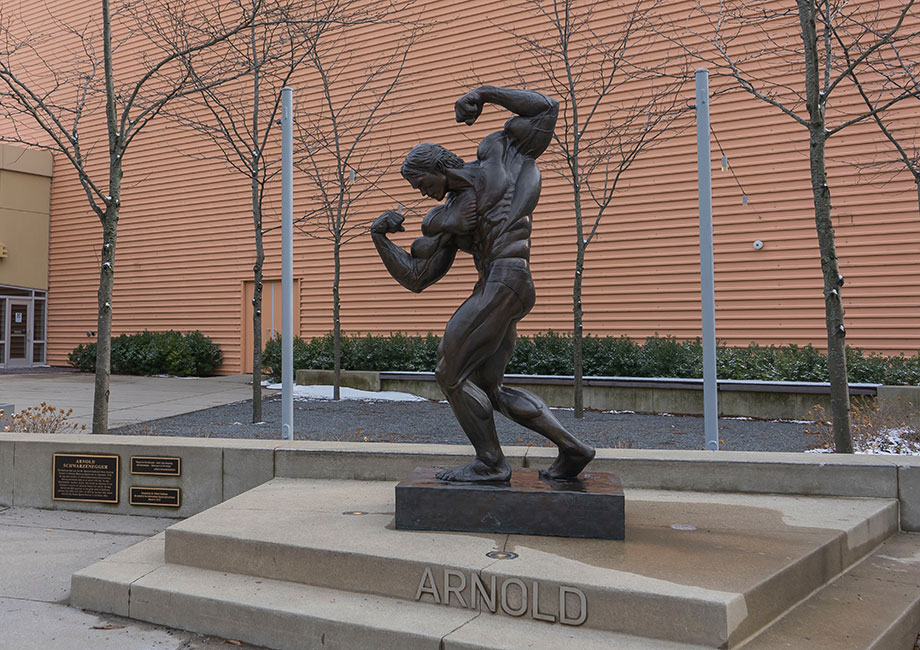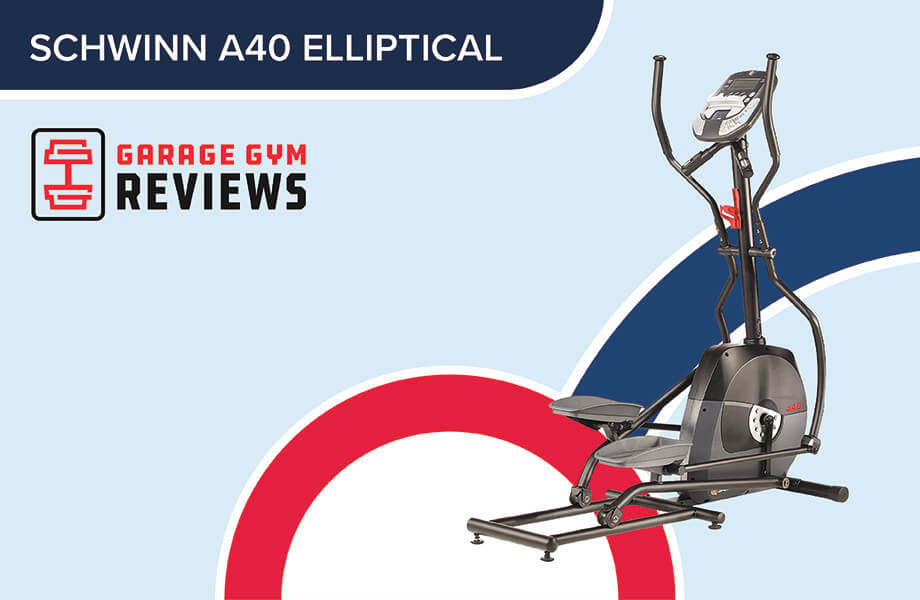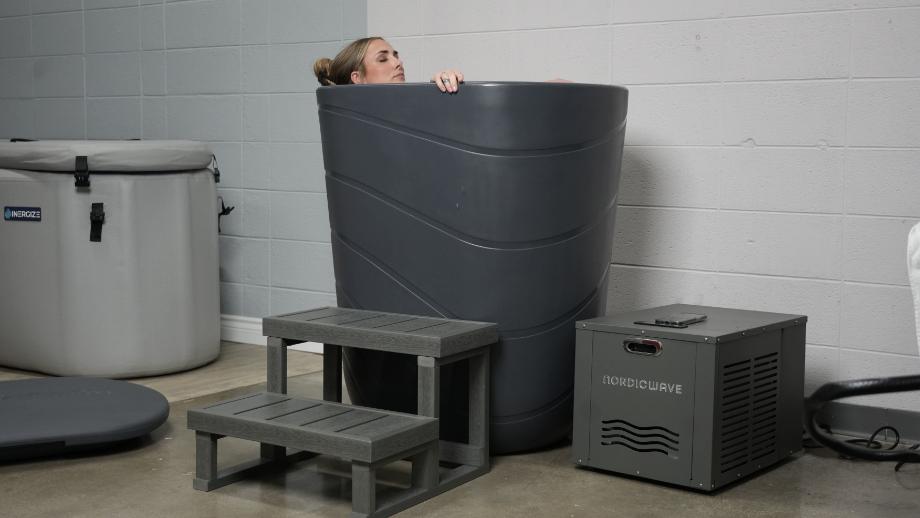The barbell has been the basis for building strength and muscle, losing fat, and increasing power since it was invented in the 1860s. It has formed a successful strength training foundation for lifers ever since and has worked for millions of people.
The barbell loads fundamental movements (think squatting and deadlifting) with progressively heavier weights, allowing the beginner lifter to get stronger over time.
As a certified personal trainer, I use the barbell with many of my clients, including people new to resistance training. Here, I will explain the best barbell exercises for the beginner, as well as provide a sample beginner barbell workout routine you can try.
Exercises for a Beginner Barbell Workout
There are a few basic exercises I recommend for people who are just starting out with the barbell:
Back Squat
Arguably, the barbell back squat is the king of all barbell exercises. It stimulates large groups of muscles because of the high amount of muscle tension needed from the upper (upper back and shoulders) and lower body (quads, glutes, and hamstrings). Primarily, however, the squat builds leg muscles. However, it also translates to other movements. For example, a British Journal of Sports Medicine study found a strong correlation between squats and jump height.
I like the back squat for beginners because there is a simple progression from performing a bodyweight squat well to putting a bar on your back and squatting with it. As you progress and get stronger, you can load the squat with more weight, or increase the number of reps you do.
How to Do It:
- Place your feet under a barbell in a squat rack that is set so the bar is just below shoulder height.
- Slightly shrug your shoulders to create a shelf on your upper back on which to rest the barbell. Be careful not to place the bar on your neck or directly on your spine.
- Unrack the bar and take just a few steps away from the rack.
- Set your feet in your squat stance, which is generally feet under the shoulders, toes pointed slightly out.
- Lower your hips to your depth while keeping the chest lifted. Once you hit your depth (which is different for everyone), drive your feet through the floor to stand up.
- Reset and repeat for desired reps.
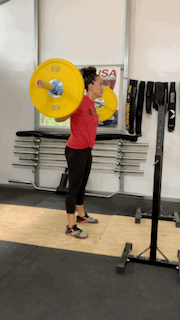
Form Tips
Pulling the barbell down into your upper back like a lat pulldown keeps your spine straight and chest lifted. If you’re having trouble with your squat depth or form, squatting to a box will help.
Romanian Deadlift (RDL)
Deadlifting from the floor is great, but when you’re a beginner, you may want to build form and technique with a less technical variation like the Romanian deadlift. The difference between the conventional barbell deadlift and the RDL is that the RDL starts in the standing position, and the bar does not go all the way to the ground. This engages more of the glutes and hamstrings due to constant tension the muscles are under, because the weight never touches the floor, which would essentially “unload” the body.
How To Do It
- Stand with good posture with your feet hip-distance apart and unrack the barbell from the squat rack using an overhand, shoulder-width grip.
- With your chest up and shoulders down, take a deep breath in and hip hinge until the barbell is below your knees. You can bend the knees slightly, keeping the bar close to your body at all times.
- Pause at the bottom range of motion before using your hamstrings and glutes to pull you back to a standing position.
- Reset and repeat for desired reps.
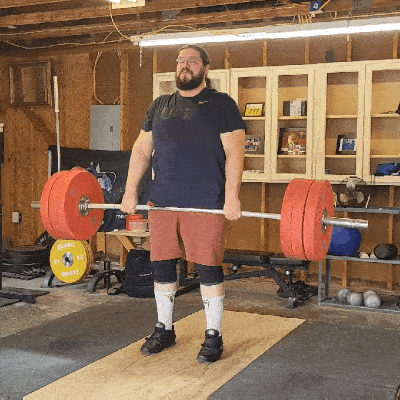
Form Tips
Start with the barbell around hip height in the squat rack to make it easy to rack and unrack. If you don’t have access to a rack, you can perform a conventional deadlift first to get the bar in the optimal position. Brushing the bar up and down your thighs ensures that you are keeping it close to your body.
Bent-Over Row
You might call the barbell row the granddaddy of all back exercises because it’s a variation that allows you to lift a substantial amount of weight. For beginners, it’s also a simple movement that you can quickly learn.
How To Do It
- With a barbell on the floor or in a rack, stand with your feet slightly more than hip-width apart under the barbell.
- Hip hinge down and grip the barbell with an overhand, shoulder-width grip.
- Start to stand, bringing the barbell to knee level with back straight and torso bent at 45 degrees.
- Bend the arms to pull the barbell between your navel and sternum.
- Slowly lower down to straight arms, and reset and repeat for reps.
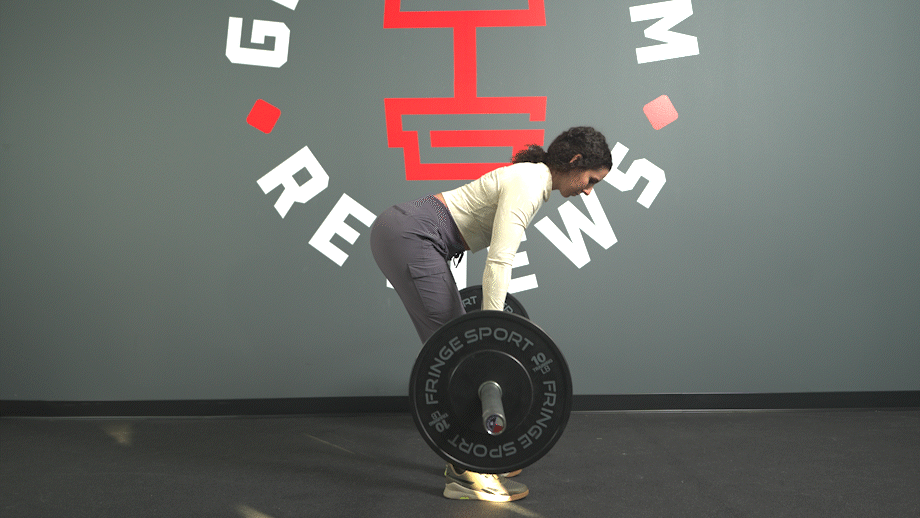
Form Tips
Keeping your shoulders down and chest up helps keep a neutral spine and a better lifting path. Bend the knees slightly during these to take tension off your hamstrings.
Overhead Press
The barbell overhead press is the foundational movement for other overhead barbell lifts, like the push press and power jerk. It is simple in nature, as you are solely moving a bar from your shoulders to above your head. Plus, it works all three deltoid heads (muscles on your shoulders), which is rare for most upper body strength exercises.
How To Do It
- Place the bar in the front rack position, above your collarbone, with your hands slightly outside your shoulders.
- Your elbows should come slightly in front of the barbell.
- Brace your core by drawing in a breath.
- Press the bar overhead until your arms are locked out with your hands directly above your shoulders.
- Slowly lower down to the starting position and repeat.
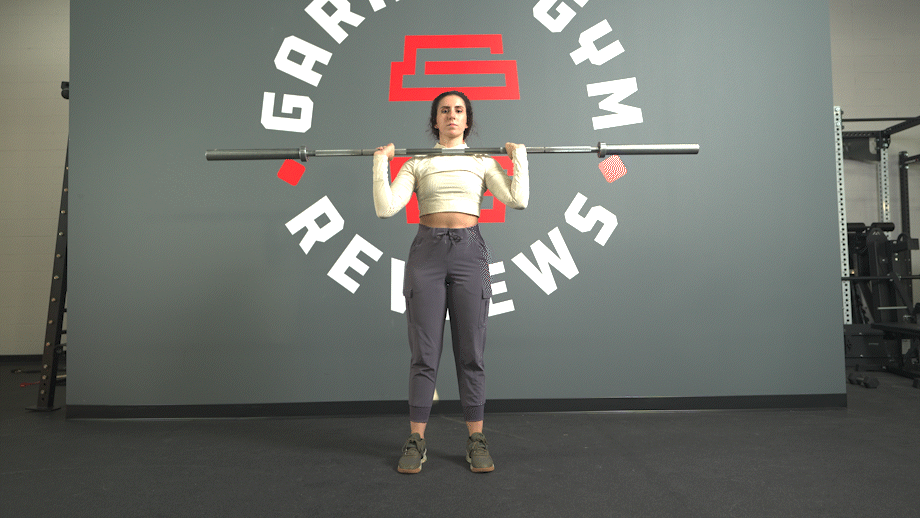
Form Tips
Squeezing your glutes during the overhead press will help prevent lower back hyperextension (leaning back too far), and will give you a stable base to press from.
Bench Press
The barbell bench press and its variations (incline, decline, close-grip) all train the chest, triceps, and shoulders to varying degrees. This is a great movement for beginners because it doesn’t require much technical skill.
The traditional barbell bench press, like most barbell exercises, allows you to use the most weight because of the straight bar path and the stability of the weight bench. This leads to more pushing strength and increased strength and mass for your upper body.
How To Do It
- Lie flat on a bench and get your nose directly underneath the barbell.
- Grip the bar with hands a little wider than shoulder-width apart.
- Bring your feet closer to your glutes under the bench
- Unrack the bar and push it directly above your chest with your elbows locked out.
- With control, lower the bar down to your chest.
- After touching your chest with the bar, raise it in a straight line until your arms are locked out.
- Reset and repeat for reps.
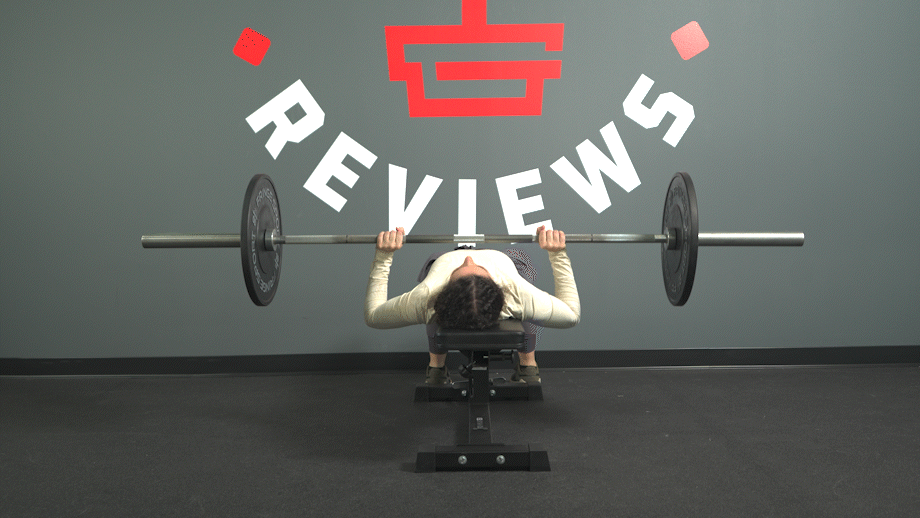
Form Tips
Beginners should always have a spotter when bench pressing. This keeps you safe as you perform the exercise.
Best Barbell
Rogue Ohio Bar
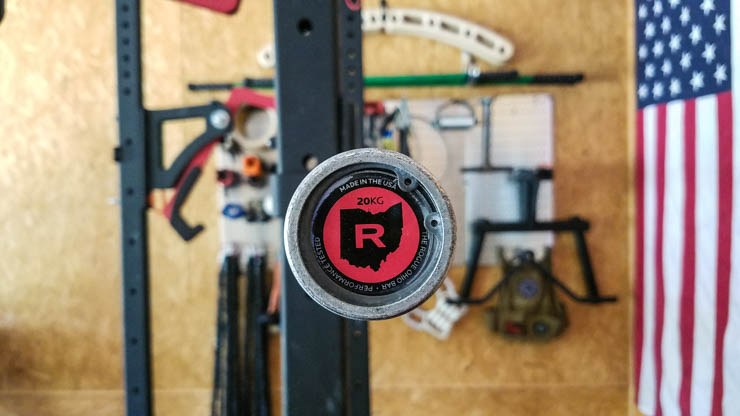
Product Highlights
- 190K PSI tensile strength
- Multipurpose bar with great versatility
- Lifetime warranty
- Bushing sleeves
- Snap ring design
Pros & Cons
Pros
- Made in the USA of US-Sourced Steel
- Somewhat passive knurling
- Grips with chalk
- Great for a variety of training styles
- Dual knurl marks
- 28.5-mm shaft
- Bronze bushings
- Lifetime warranty
- Coatings include stainless steel, Cerakote, black zinc, and more.
- 190K tensile strength
Cons
- Not outstanding for powerlifting or weightlifting in comparison to more specialized bars
- Expensive
- Diameter doesn't meet IWF standards
- No center knurl, which may matter to some
Bottom Line
The Rogue Ohio Bar is one of the most iconic barbells in the world. It's been used at the CrossFit Games by some of the fittest athletes in the world and is just as well suited in your garage gym. The Ohio Bar is priced well despite its features and being made in the USA. Although we prefer the Rogue 2.0 Bar for its price, we don't blame you if you decide to spring for the Ohio Bar, although we'd suggest getting the Stainless Steel or Cerakote version.
Beginner Barbell Workout
Before the full-body workout comes the warmup. There are two main parts of a barbell warmup.
First is a general total-body warmup to get the blood flowing. You can start with several rounds of dynamic stretches, such as quad pulls, arm circles, and jumping jacks.
Second is to perform lightweight barbell movements of the exercises you will be performing. Here’s an example of a ramp-up set for barbell back squat:
- 10 reps with an empty barbell
- 8 reps at 40% of your one-rep max
- 6 reps with 50% of your one-rep max
- 5 reps with 60% of your one-rep max
- 4 reps with 60%+ of your one-rep max
If you don’t know your one-rep max, which many beginners do not, simply start with an empty bar and make small jumps in weight, keeping the movement lighter during warm-up sets. This primes your body for the movement and allows you to dial in technique.
For beginners, I like the following beginner barbell training program, which each workout performed as a circuit:

Day One:
Two to Four Rounds:
6-12 back squats at a moderate weight
6-12 bench press at a moderate weight
30-sec to 1-min plank
6-12 bent-over row at a moderate weight
12-15 bodyweight reverse lunges (each side)
Day Two
Two to Four Rounds:
6-12 Romanian deadlifts at moderate weight
6-12 overhead presses at moderate weight
15 to 30-sec side plank (each side)
6-12 bent-over rows
6-10 push-ups
Instructions
Take 60 to 90 seconds in between exercises on each circuit, resting up to 2 minutes in between rounds. As you progress, you can add more weight to the bar or add more reps.
Benefits of a Barbell Workout
There are several benefits of barbell training for just about anyone, from the beginner to the powerlifting elite.
Easy to Add Weight
Progressive overload is a tried-and-true method of training that enables you to gradually get stronger by adding more weight to your exercises. Barbells tend to be easy to add weight to, because it’s just a matter of sliding another plate on the bar. Depending on the equipment you have, these can be pretty small jumps, as there are plates that weigh just 1 pound.
Dumbbells, kettlebells, and machines only go so high, or have set incremental changes. With a barbell, you can easily add or subtract as much weight as you have plates.
Versatility
Whether your goal is to build strength or lose weight, the barbell can help get you there. You can use it for strength-based training to build muscle, or you can use light barbells in HIIT training to accomplish other fitness goals.
RELATED: HIIT Bike Workout
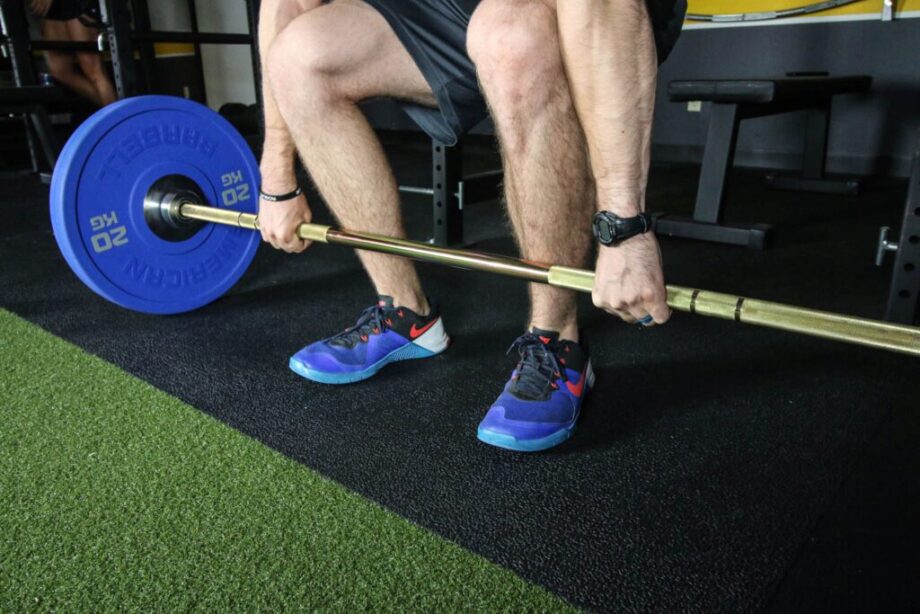
Additionally, a barbell can be used to work all the major muscle groups in your body. Consider that you can use a barbell while standing (like you would with barbell squats), or sitting (for something like a seated press), or you can wedge it into a corner for landmine training.
Better Stability
The barbell is a long, fixed piece of home gym equipment. The even weight distribution makes for great stability, compared to something like a kettlebell, where the weight is not distributed evenly. This means that the bar is less likely to move out of its intended path while you’re lifting, which is great for injury prevention.
How Heavy Should My Barbell Be?
The weight of your bar largely depends on your fitness level and strength. Lifting a barbell that’s too heavy may result in injury, or lifting one that is too light may result in your goals not being met.
For beginners, practicing movements with an empty bar is preferable so you can master the movement. Barbells come in two main weights: 20 kilograms (or about 44 pounds), and 15 kilograms (or about 33 pounds). However, you can find barbells that are 10 kilograms (22 pounds) or 15-pound bars often-called “training bars.” And, of course, once you are ready, you can add weight plates to make exercises more challenging.
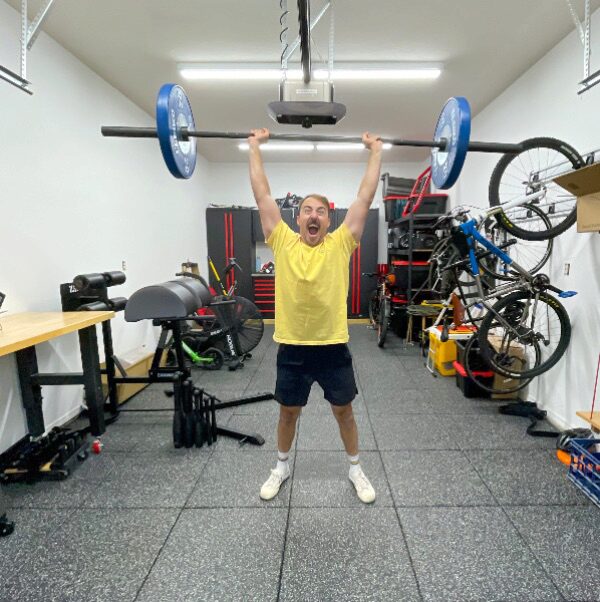
Tips for Barbell Workouts
Before jumping in to barbell lifts, it’s ideal to know how to be safe while doing them:
- Performing a warm-up is essential to get your joints ready for action and to prevent injury before lifting.
- Using barbell collars will prevent plates from sliding off the bar, which can lead to serious injury.
- Setting the barbell at the correct height for the squat, bench press, RDL, and overhead press saves unnecessary stress and strain on your body.
- I advise having a spotter, personal trainer, or training partner observe your lifts, both to ensure your safety but also to pick up on ways you can improve your form.
- Prioritize form over weight, especially at the beginning. Pushing yourself is fine, but not at the expense of getting hurt.
Final Thoughts
Since the 1860s, the barbell has helped millions of people get fit. The ability to load the barbell with progressively heavier weights, the fixed range of motion, and the relative stability of the barbell makes it an attractive proposition for all lifters, including beginners.
Best Multipurpose Budget Barbell
Fringe Sport Wonder Bar V2 20KG Barbell

Product Highlights
- Ideal as a multi-purpose bar
- Dual knurl marks
- 205,000 PSI
- Fringe Sport has free shipping
- Lifetime warranty
Pros & Cons
Pros
- Knurling is somewhat passive
- Ideal as a multi-purpose bar
- Dual knurl marks
- 205,000 PSI
- Bearings or bushing are available
- 28MM in diameter
- Fringe Sport has free shipping
- Lifetime warranty
Cons
- Black zinc finish will fade over time
- Sleeves prone to scarring rather quickly
- Not made in USA
Bottom Line
The Fringe Sport Wonder Bar V2 is one of the best value general training/CrossFit barbells on the market that we've reviewed. For under $200 you get a crazy good spec sheet and a barbell that will perform in any workouts for as long as you keep it. If you're on a budget, but want a great barbell, we suggest this one.
FAQs About Beginner Barbell Workouts
Can beginners use a barbell?
Yes, they can. When the focus is on form and not weight, beginners can lift a barbell safely without injury. I recommend getting comfortable with barbell movements using an empty bar before adding weight.
What weight should a barbell be?
Most Olympic weight lifting bars weigh 20 kilograms (about 44 pounds) or 15 kilograms (33 pounds). The weight that is right for you is the one that matches your ability level. Typically, men lift with 20-kilogram bars and women with 15-kilogram bars, mostly because the shaft of the 15-kilogram is thinner, which is ideal for people with smaller hands.
What workout should a beginner start with?
Beginners should start with bodyweight and low-weight movements before moving onto heavier loads. For example, someone should be able to perform a technically sound air squat before performing a barbell squat.
Can you gain muscle with just a barbell?
Barbells are a great way to build muscle because they give you the ability to work all major muscle groups and can go up in weight as you get stronger. To build muscle effectively, it is ideal to eat a balanced diet with plenty of protein as well.


